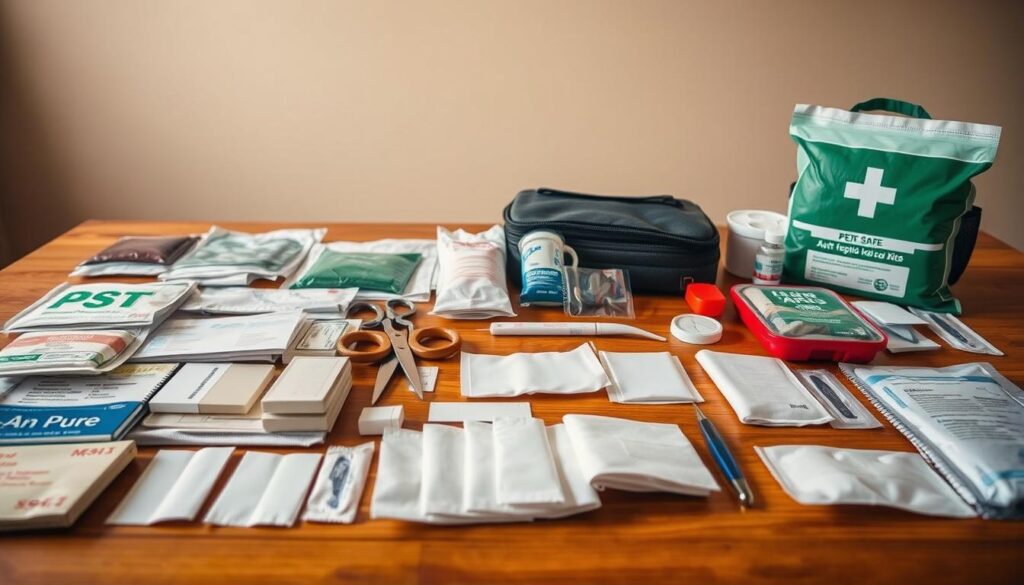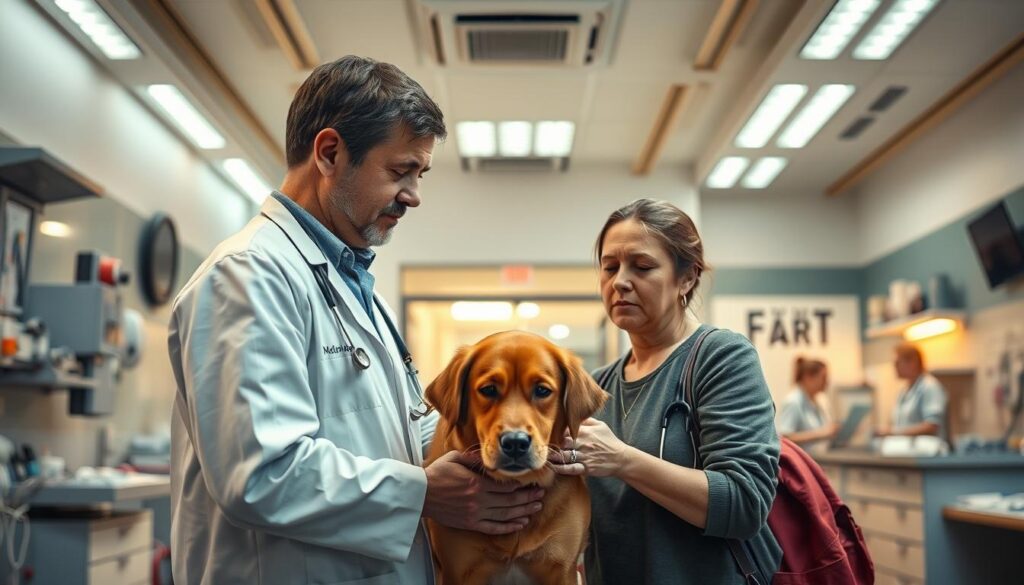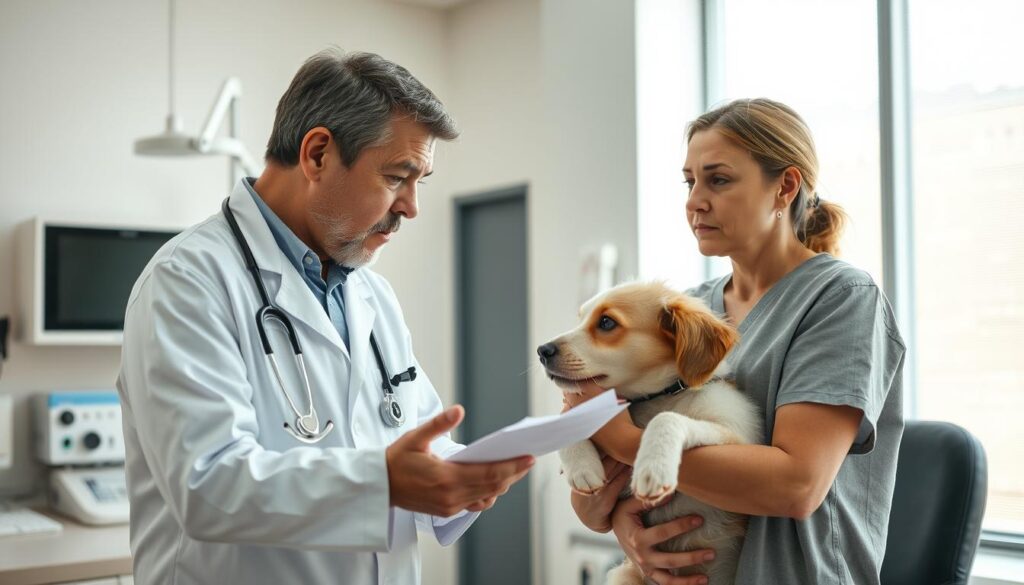Traveling internationally with your pet can be a wonderful experience. But, it’s crucial to be prepared for any medical emergencies that may arise.
Before embarking on your journey, it’s essential to understand the importance of emergency vet care abroad. Take necessary steps to ensure your pet’s health and safety.
Preparing your pet’s medical documents and understanding pet health risks in different regions are vital aspects of international pet travel.
Key Takeaways
- Research local vet care options before traveling.
- Ensure your pet’s vaccinations are up-to-date.
- Carry a pet first-aid kit.
- Understand local pet health risks.
- Keep essential phone numbers handy.
Preparing for Pet Emergencies Before International Travel
When you’re getting ready to travel internationally with your pet, it’s key to make sure they’re healthy and safe. Traveling abroad is fun for both you and your pet. But, it also brings special challenges, like dealing with medical emergencies.

Essential Pet Medical Documents to Pack
Getting your pet’s essential medical documents ready is a crucial step. You’ll need your pet’s vaccination records, health certificates, and any medical history. Having these documents ready can help get your pet the care they need in foreign countries.
Pre-Travel Veterinary Check-ups and Vaccinations
Make sure to schedule a pre-travel veterinary check-up for your pet before you go. This visit can spot any health problems that need fixing before your trip. Your vet can also tell you which vaccinations your pet needs for your destination.
Creating a Pet First Aid Kit for International Travel
A pet first aid kit is a must-have for traveling with your pet. It should have bandages, antiseptic wipes, tweezers, and any medicines your pet needs. Don’t forget to pack a copy of your pet’s medical records and your vet’s contact info.
Other important items for your pet first aid kit are:
- Muzzle or Elizabethan collar
- Thermometer
- Scissors and tick remover
- Any specific medications for your pet’s known conditions
With the right documents, check-ups, and a first aid kit, you can lower the risks of traveling internationally with your pet.
Understanding Pet Health Risks in Different Regions
Different parts of the world have unique health risks for pets. Knowing these risks is crucial to keep your pets safe. When traveling with your pet, understanding these risks helps you take the right steps to protect their health.

Common Health Threats in Tropical Destinations
Tropical places often have a higher risk of diseases like heartworms and leishmaniasis. These diseases spread through mosquito bites. So, it’s important to use mosquito repellents and get regular vet check-ups.
European Pet Health Concerns
In Europe, pets face risks from parvovirus and distemper. Make sure your pet’s vaccinations are current before heading to Europe. This can greatly lower the risk of these diseases.
Asian and Pacific Region Pet Risks
The Asian and Pacific areas have their own health concerns for pets. These include snake bites and heatstroke. Knowing these risks and taking steps like avoiding snakes and keeping your pet hydrated can help prevent them.
By knowing the health risks of your destination, you can prepare your pet for travel. This ensures a safer and healthier trip for them.
How to Find Emergency Vets When Traveling Internationally
Finding emergency vet care abroad is key for pet owners. Even with planning, pet emergencies can happen. Knowing where to find local vets can save your pet’s life.
Digital Resources and Apps for Locating Foreign Veterinarians
Today, many digital tools help find emergency vets abroad. Apps like PetFinder and the International Veterinary Association directory are great. They let you find vets near you.
Pet travel insurance also helps. It includes lists of vets and clinics for international pet owners. Download useful apps or save websites on your phone before you go.

Working with Your Hotel or Accommodation for Vet Referrals
Hotels can suggest local vets. Pet-friendly hotels often have vet lists. Always ask for vet recommendations when you arrive.
Some hotels even offer pet-sitting or have vet partnerships. Building a good relationship with hotel staff can help in emergencies.
| Resource | Description | Usefulness |
|---|---|---|
| PetFinder App | Directory of veterinarians and pet care services | High |
| Hotel Referrals | Local vet recommendations from hotel staff | High |
| Pet Travel Insurance | Emergency assistance and vet directories | High |
Embassy and Consulate Assistance for Pet Emergencies
Your embassy or consulate can help in a pet emergency. They can guide you to local vets and help with local authorities.
Registering with your embassy is wise. It gives safety updates and helps in emergencies. They can reach out to your family or offer support.
Use digital tools, hotel help, and embassy support. This way, your pet gets the care they need, even abroad.
Overcoming Language Barriers in Pet Emergency Situations
Traveling abroad with pets can be tough. One big challenge is finding vet care when you don’t speak the local language. It’s key to talk clearly in emergencies, but language barriers can make it hard.

Translation Apps and Services for Veterinary Needs
Translation apps and services can help a lot. Apps like Google Translate can translate words and speech in real-time. This helps you tell the vet about your pet’s health issues. Some services even offer live interpreters, which can be super helpful in tough cases.
Universal Medical Terms for Pet Emergencies
Learning universal medical terms for pets can help. Words like “vomiting,” “diarrhea,” “seizure,” and “allergic reaction” are common in many languages. Knowing these can make basic communication easier. Keep a list of these terms with you.
| English | Spanish | French |
|---|---|---|
| Vomiting | Vómitos | Vomissements |
| Diarrhea | Diarrea | Diarrhée |
| Seizure | Crisis epiléptica | Crise épileptique |
Preparing Multilingual Pet Medical Information Cards
Make multilingual pet medical cards for quick vet info. Include your pet’s health history, allergies, meds, and your contact details. Having this info in many languages can speed up care in emergencies.
Pet Insurance and Payment Considerations Abroad
Traveling with your pet abroad requires the right insurance. Pet insurance can protect your finances in a pet emergency.
Choosing the right international pet insurance is key. Look at coverage, deductibles, and what’s not covered.
International Pet Insurance Options and Coverage
Many insurance companies offer plans for pets traveling abroad. Coverage can differ a lot. Important things to think about include:
- Coverage for accidents and illnesses
- Emergency surgeries and hospitalizations
- Prescription medications
It’s important to know what’s covered and what’s not before you buy a policy.
Understanding Foreign Veterinary Costs by Region
Vet costs change a lot by region. Knowing these costs helps with trip planning and budgeting.
| Region | Average Cost of Vet Visit | Average Cost of Emergency Surgery |
|---|---|---|
| North America | $50-$100 | $1,000-$3,000 |
| Europe | $30-$70 | $800-$2,500 |
| Asia/Pacific | $20-$50 | $500-$2,000 |
Payment Methods Accepted by International Vets
Not all vets abroad take the same payments. It’s wise to:
- Carry local currency for vet visits
- Have a credit card with no foreign transaction fees
- Check your vet’s payment policies before they treat your pet

Recognizing and Responding to Common Pet Emergencies Abroad
Traveling with pets abroad means being ready for emergencies. Emergencies can happen anytime. Being prepared keeps your pet safe and healthy.
Signs of Heat Stroke and Dehydration in Dogs and Cats
Heat stroke and dehydration are big risks for pets in hot places. Look for signs like too much panting, drooling, and feeling very tired. If you see these, move your pet to a cooler spot and give them water. For serious cases, get vet help fast.
Handling Injuries and Accidents in Unfamiliar Environments
Unfamiliar places can be dangerous for pets. They might get hurt or meet wild animals. Watch your pet closely and keep them safe or on a leash. If they get hurt, a basic first aid kit and knowing how to use it can save their life.
Identifying Food Poisoning and Toxic Ingestion While Traveling
Traveling with pets means they might eat something bad. Signs of food poisoning include throwing up, diarrhea, and feeling very weak. If you think your pet ate something bad, get vet help right away. Have emergency numbers ready, like vet offices and pet poison hotlines.
Being ready for pet emergencies while traveling is very important. Knowing the signs and how to act can make your trip safer and more fun for you and your pet.
Navigating Different Veterinary Standards Around the World
Traveling internationally with pets means you need to know about different veterinary care standards. When you take your pets to foreign lands, it’s key to understand these differences. This ensures they get the best care possible.
“The standard of veterinary care can vary significantly from one country to another,” says Dr. Jane Smith, a vet with lots of international experience. This shows how important it is to be ready.
Western vs. Eastern Veterinary Approaches
Veterinary care methods differ between Western and Eastern countries. Western medicine uses evidence and advanced tech. Eastern methods might include traditional and holistic treatments.
In some Asian countries, vets use acupuncture and herbal remedies. This is part of their care approach.
Developed vs. Developing Country Vet Care Standards
Veterinary care standards also change between developed and developing countries. Developed nations have better clinics and tools. They also follow strict rules.
But, developing countries might struggle with limited resources and poor infrastructure.
Recognizing Quality Veterinary Care Internationally
To make sure your pet gets good care abroad, look for clinics with modern gear and clean places. It’s also key to research local vets before you go and have emergency contacts ready.
Knowing the differences in veterinary standards helps you navigate care abroad well. This way, you can keep your pets safe and healthy on your travels.
Technology Tools for Pet Emergency Management Abroad
Traveling abroad with your pet? The right tech can save lives in emergencies. Being ready with the latest pet care tools is key.
Pet Health Monitoring Devices for Travel
Pet health monitoring devices are a hit among travelers. They track vital signs like heart rate and temperature live. For example, PetPace and Whistle offer GPS and health tracking. This gives pet owners peace of mind on the go.
Telemedicine Options for International Veterinary Consultations
Telemedicine has changed how we get medical help, including for pets. Services like Petcube let you video chat with vets. This is super useful when you’re abroad and need quick advice. It means your pet can get the care they need without a face-to-face visit.
GPS and Location Services for Emergency Situations
Lost pets can be a big worry when traveling. GPS and location services help a lot. Devices like Tractive let you track your pet’s location in real-time. They also offer features like activity tracking and alerts for when your pet leaves a safe area.
Using these tech tools can greatly lower the risks of traveling with pets abroad. They help with health monitoring, remote vet care, and tracking your pet’s location. Technology is a great help in keeping your pet safe and happy on international trips.
Post-Emergency Care and Quarantine Considerations
Traveling with pets internationally means you need a solid plan for emergencies and care after. If your pet has a medical emergency abroad, their care doesn’t end with the first treatment. It’s key to make sure they get the right post-emergency care to heal and stay healthy.
Medication Management in Foreign Countries
Managing your pet’s medicine while traveling abroad needs careful thought. Make sure you have enough of their prescribed medicines. Also, know the rules about bringing and using pet medicines in the country you’re in. Carry a medication list with you, listing the medicines, how much to take, and your vet’s contact info.
Follow-up Care and Monitoring While Abroad
After an emergency, your pet needs ongoing care. Look up local vets who can help and talk to your home vet if you can. Keeping records of your pet’s treatment and any future vet visits is key for their care to keep going smoothly.
Re-entry Requirements After Foreign Veterinary Treatment
Before you bring your pet back home, you must meet certain re-entry requirements. This might mean getting a health certificate from a vet before you leave, making sure all shots are current, and possibly following quarantine rules. Knowing these requirements ahead of time can avoid problems when you get back.
It’s important to understand quarantine considerations and re-entry rules for pets after vet visits abroad. With good planning and staying informed, you can make sure your pet’s health and follow the rules for a smooth return.
Conclusion: Ensuring Your Pet’s Safety During International Adventures
Traveling abroad with your pet can be rewarding but needs careful planning. You must understand the risks of international pet travel. This way, you can have a safe and fun trip with your pet.
Getting your pet’s medical documents ready and knowing different vet standards are key. Having access to emergency vet care is also crucial. By focusing on pet safety, you can reduce risks and make the journey smooth for both you and your pet.
When planning your international trip, remember that emergency vet care is vital for pet safety. Being prepared and knowing what to expect helps provide the best care for your pet. With the right preparation, you can have a worry-free trip with your pet.







